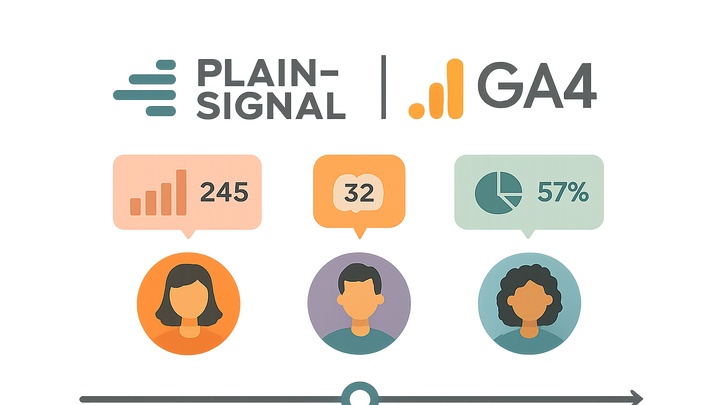Published on 2025-06-28T08:33:06Z
What is Cross-Sectional Data? Examples
Cross-sectional data is a type of observational data collected at a single point in time across multiple subjects or entities. In the field of analytics, it offers a snapshot view of user behavior, system performance, or market conditions at a specific moment, enabling businesses to derive insights without tracking changes over time. Unlike longitudinal or time series data, cross-sectional data does not capture temporal dynamics, but it simplifies analysis by focusing on one time slice. This approach is widely used for benchmarking, cohort comparisons, and resource-efficient data collection. Common tools like PlainSignal (a cookie-free simple analytics platform) and Google Analytics 4 (GA4) can be configured to collect cross-sectional datasets, providing immediate visibility into key metrics. By understanding its strengths and limitations, analysts can apply cross-sectional data effectively to inform strategic decisions.
Cross-sectional data
Snapshot data collected at one point in time across subjects, enabling quick insights and comparisons in analytics.
Definition and Context
This section defines cross-sectional data and explains its role within analytics. It clarifies how it differs from related concepts and why it’s vital for quick, snapshot analysis.
-
Definition
Cross-sectional data consists of observations collected at a single point in time across multiple subjects or units. It provides a snapshot of metrics like pageviews, user demographics, or system status without tracking changes over time.
-
Context in analytics
In analytics, cross-sectional data is used to compare performance across segments (e.g., traffic sources, user cohorts) at a specific moment, aiding in benchmarking and making immediate decisions.
Importance in Analytics
Cross-sectional data enables fast decision-making, efficient resource usage, and clear benchmarking by focusing on a single time frame. It supports various analysis types without the complexity of temporal tracking.
-
Quick insights
Provides almost instantaneous analysis of performance metrics, allowing rapid response to user behavior or system events.
-
Benchmarking
Allows businesses to compare different segments or channels side by side at the same point in time, facilitating performance evaluation.
-
Resource efficiency
Simplifies data collection and storage by avoiding long-term tracking, reducing complexity and cost.
Comparison with Other Data Types
Understanding how cross-sectional data differs from other data types helps analysts choose the right approach for their needs.
-
Longitudinal data
Longitudinal data tracks the same subjects over multiple time points, revealing trends and causal relationships, whereas cross-sectional data offers only a single snapshot.
-
Time series data
Time series data records sequential observations over time for a single metric, ideal for trend analysis but not for cross-subject comparisons at one time.
-
Panel data
Panel data combines cross-sectional and time series by observing multiple subjects across time, providing both cross-sectional and temporal insights.
Collecting Cross-Sectional Data
This section outlines common methods to gather cross-sectional data, including analytics tools implementation and survey approaches.
-
Single-day snapshots
Collects data for a 24-hour period to capture daily performance metrics, often used in A/B testing or daily reporting.
-
Surveys and polls
Gathers responses at one point in time through questionnaires, useful for capturing user sentiment or preferences.
-
Analytics tools implementation
Modern analytics platforms like PlainSignal and GA4 can be configured to capture cross-sectional data. Example implementations:
PlainSignal:
<link rel="preconnect" href="//eu.plainsignal.com/" crossorigin /> <script defer data-do="yourwebsitedomain.com" data-id="0GQV1xmtzQQ" data-api="//eu.plainsignal.com" src="//cdn.plainsignal.com/plainsignal-min.js"></script>GA4 (Gtag.js):
<!-- Global site tag (gtag.js) - Google Analytics --> <script async src="https://www.googletagmanager.com/gtag/js?id=G-XXXXXXXXXX"></script> <script> window.dataLayer = window.dataLayer || []; function gtag(){dataLayer.push(arguments);} gtag('js', new Date()); gtag('config', 'G-XXXXXXXXXX', { 'send_page_view': true }); </script>
Limitations
While useful, cross-sectional data has constraints that analysts should consider when interpreting results.
-
Temporal limitations
It does not track changes over time, so it cannot reveal trends, seasonality, or growth patterns.
-
Causality inference
Since it’s a single snapshot, it cannot establish cause-and-effect relationships.
-
Data freshness
Rapidly changing environments may render cross-sectional snapshots outdated quickly.
Best Practices
Tips to maximize the value of cross-sectional data in analytics and ensure snapshot insights are accurate and actionable.
-
Define clear objectives
Identify specific questions the snapshot should answer, such as comparing user segments or evaluating campaign performance.
-
Ensure data quality
Validate data sources, handle missing values, and confirm accurate timestamp alignment to maintain snapshot integrity.
-
Regular snapshots
Schedule consistent data captures (daily, weekly, or monthly) to build a series of cross-sectional datasets for comparative analyses.
